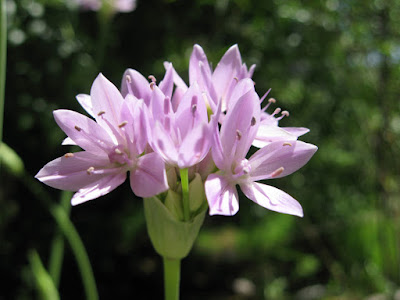 |
| Goldenstars (Bloomeria crocea) brighten the spring garden. |
Gardening
for health is more than just exercise doing garden chores. It’s about designing gardens to help combat
the stresses of daily modern life. The
digital era compounds our sense of urgency: there’s something new
to worry about every few minutes. This constant
pressure is stressful – it wears us down. One way that gardens promote health is by
taking us out of this toxic environment - at least for a little while. And there are tricks to make your garden
experience even more healthful.
In
the natural world, Mother Nature doles out her treats a little at a time. If you live (or once lived) near a natural
area, you know what we mean. In S.
California, the currants and gooseberries surprise with their blooms early in
the year. Lupines enchant with their
rain-drenched colors in February and March; they also attract the early flying
pollinators, like the bumblebees. And so
on through the seasons. Each month brings special treats to anticipate and keep
us coming back.
A
natural place is never quite the same when we revisit it. Some things stay the same (or nearly so). But other elements change, month to month and
year to year. Mother Nature gets the balance right: enough constancy and enough
change. Too little change is boring; too
much can be overwhelming. Because nature
hits the sweet spot we keep returning, both to relax and to see what’s new.
Nature is simply irresistible!
We
can adapt nature’s seasonal tricks in planning our gardens. Most gardens include plants that stay pretty
much the same throughout the year.
Evergreen trees and shrubs are good backbone plants because they provide
sameness. The constancy is calming, relaxing
and reassuring. It’s something your
family can count on, year after year.
Such enduring views are even more important in an era of rapid change.
But
we also need to plan for seasonal ‘treats’; things that give the garden a
special allure at certain times of the year.
Among our favorite seasonal elements are the native geophytes (bulbs,
corms and rhizomatous perennials). They
are easy to grow and that’s reason enough to use them. They increase every year and naturalize in
the garden – also good traits.
 |
| Wild hyacinth (Dichelostemma capitatum) |
But
native bulbs, corms and rhizomatous perennials also are some of the best ways
to add seasonal interest to a garden. In
Mother Nature’s Backyard, we look forward to the emergence of new bulb leaves
every winter/spring. Then we monitor the
progress of developing buds over the weeks.
Finally, the flowers emerge – each species according to its season –
providing a moment of glorious color (and sometimes scent). Native geophytes engage, delight and surprise
us – every year, year after year.
Native
geophytes provide something that’s often lost in contemporary gardens – a sense of time. They give us a treat to look forward to. We treasure their ephemeral flowers, knowing
that their limited engagement makes them all the more special. And we know they will return, at the proper
time, year after year. The geophytes
provide something rare: that perfect blend of change and constancy that our
contemporary world so desperately needs.
So
spend a few months learning about the geophytes native to your area. Think about places where they might succeed
in your garden. Many do well in
containers, so even a small garden can utilize them. Be sure to order your bulbs early (July or
August is good – they won’t be shipped until fall). Then plant a little bit of healthful magic
in the form of bulbs and corms. Trust
us, you’ll feel happier – and healthier – for doing so.
For more on
gardening with native bulbs see:
- http://mother-natures-backyard.blogspot.com/2017/02/gardening-with-california-native-bulbs.html
- http://mother-natures-backyard.blogspot.com/2017/03/plant-of-month-march-wild-hyacinth-blue.html
- http://mother-natures-backyard.blogspot.com/2017/05/plant-of-month-may-california-brodiaea.html
- http://mother-natures-backyard.blogspot.com/2018/04/plant-of-month-april-meadow-onion.html
For more posts in this series see: http://mother-natures-backyard.blogspot.com/2018/01/gardening-for-health-1-go-hug-tree-for.html
__________________















